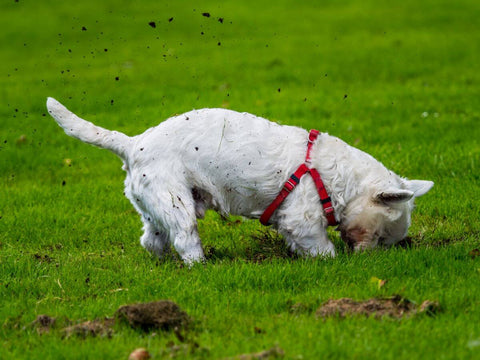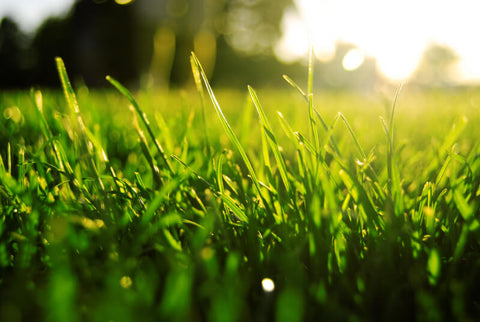Dogs are excellent companions, but their presence can sometimes wreak havoc on my lawn. But you can have a green lawn even with dogs running around.
In fact, I prioritize the health of my grass for aesthetic reasons and for the well-being of my dog and myself.
In this article, I'll give you some tips on how to do it. Let`s begin.

Maintaining Green Lawns with Dogs
As a dog owner, you may wonder why it is crucial to keep your grass green when your energetic buddy loves to dig, run, and play on it.
Maintaining a healthy lawn holds several benefits, both for your furry friend and yourself:
- A vibrant green lawn offers a comfortable and fun area for your dog to play. It lowers injury risk, cushions joints while playing, and provides a cool surface on hot summer days.
- Exercising on grass makes pups stronger, coordinated, and healthier.
- A lush green lawn minimizes dirt and mud, reducing the mess your dogs can track into your home. It acts as a natural air filter, trapping dust and allergens, improving air quality around your property.
- A well-maintained lawn improves property aesthetics and value. It creates an inviting environment for friends, family, and guests, enhancing outdoor enjoyment.
Now let's see how dogs impact grass.
Exploring Dogs' Impact on Grass

Dogs significantly affect your lawn's health and appearance: from urine spots to digging behaviors.
Dog Urine and Its Effects on Grass Health
When dogs pee on the grass, it can lead to yellow spots. Their urine contains a lot of nitrogen, which acts as a fertilizer.
As the water in their pee evaporates, what's left behind is a high concentration of nitrogen. If left untreated, the grass will appear brown at the center and green at the edges where the nitrogen is less concentrated, which leaves those nasty yellow marks.
Source: The American Kennel Club
How to Keep Grass Green From Dog Pee
To deal with dog pee spots on your lawn, try these:
- If the affected area is dark green, use more nitrogen fertilizer or apply it more often across the yard to cover up the growth and color changes caused by urine. Make sure you water enough to stop salt buildup in the soil.
- If the affected area is brown, give the plants extra water to flush the salt buildup.
Once the turf has died, you can remove the dead sod along with a layer of soil measuring 0.5-1 inch. Re-turf the area with fresh grass.
- Ensure your dog drinks plenty of water, so their pee isn't too strong.
- Consult your veterinarian before adding any supplements to your pet's food.
Certain additives can have unintended consequences on a dog's health despite increasing water intake.
Source: healthypawsanimalhospital
- Teach your dog to pee in a designated spot away from the grass. Opt for a mulch or gravel-covered area, or a location where dog spotting won't be an aesthetic issue. This is the ONLY sure solution for the problem! The allocated area will also assists you in yard cleaning and upkeep.

Dog Digging and Lawn Damage
Reasons why dogs dig in the yard:
Some dogs dig to find a cool spot, others to bury things or fulfill their prey drive.
Knowing why your dog digs can help resolve the problem.
Tips to prevent dog digging and maintain your lawn:
- Make sure they have other ways to release their energy and instincts.
- Keep your dog active with regular exercise and interactive toys.
- You can make special sand or soft soil digging spots so they don't dig up the lawn.
- Think about adding dog-friendly landscaping features like strong fences, shady spots, and areas for play.
How to Protect Grass from Dog Running

Manage Dog Playtime and Lawn Care
Finding a balance between dogs' playtime and lawn care is crucial for a green lawn. Follow these tips to minimize a dog ruining grass:
- Set aside dedicated dog play areas in your yard to protect the grass.
- Create a playtime routine for your dogs to release energy while minimizing grass time.
- Rotate the play areas to distribute wear on your lawn evenly.
Lawn Activities Suitable for Dogs
Consider these suggestions for entertaining your dogs without harming your grass:
- Establish a non-invasive obstacle course by using cones, tunnels, or hula hoops.
- Avoid hard objects that could damage the lawn when playing fetch with your dogs.
- Try mentally stimulating activities to prevent your dogs from digging up the yard.
Lawn Activities Suitable for Dogs
Consider these suggestions for entertaining your dogs without harming your grass:
- Establish a non-invasive obstacle course using cones, tunnels, or hula hoops.
- Avoid hard objects that could damage the lawn when playing fetch with your dogs.
- Try mentally stimulating activities to prevent your dogs from digging up the yard.
Creating a Dog-Friendly Yard

To keep your grass green and your dog happy, consider these tips for creating a dog-friendly yard.
Choose Pet Tolerant Grass
Some grass types can handle our furry friends better than others.
Look at these resilient grass varieties:
Tall Fescue: It's great for heavy foot traffic and doggy playtime.
Bermuda Grass: Resistant to salty conditions and quick to recover.
Zoysia Grass: Its dense mat prevents dogs from digging and shields soil from urine damage.
Factors to keep in mind when selecting dog-friendly grass:
Climate: Select a grass variety suited to your region's climate.
Shade Tolerance: Choose shade-tolerant grass for yards with trees.
Maintenance Level: Certain grass varieties need more maintenance.
Enhance Soil Health for Dog-Friendly Lawns
Grass health relies on soil quality. A dog-friendly yard requires nutrient-rich soil for resilient grass.
Here's why soil health is crucial:
Grass Resilience: Healthy soil helps grass resist the stress from dog activities.
Root Development: Healthy soil = strong root growth = lush lawn.
Consider these methods to improve soil health in dog-friendly yards:
Aerate the Soil: Regular aeration of soil enhances drainage and root access.
Ensure Proper pH: Check soil pH and adjust for optimal grass growth.
Add Pet-Friendly Fertilizer: Seek organic, natural fertilizers that are chemical-free.
Using pet-friendly fertilizers has benefits like:
- Avoiding the risk of dogs' chemical burns or toxicity.
- Letting your dog roam freely in the yard without constant supervision.
- Keeping your lawn healthy while protecting your dog's well-being.
Dispose of Pet Waste Correctly
Proper pet waste disposal prevents contamination and odor. Here are the steps:
Scoop and Bag: Remember to scoop and bag with a poop scoop or a special tool for dog waste.
Seal the Bag: Tie the bag tightly to avoid leakage or odor. Consider double-bagging for added protection.
Dispose in Designated Trash: Put the sealed dog waste bag in a designated trash can.
Flushing or Composting: Be mindful of flushing dog waste or adding it to your compost to prevent contamination.
Pet waste doesn’t just decompose. It adds harmful bacteria and
nutrients to local waters, when it’s not disposed of properly.Source: United States Environmental Protection Agency (.gov)
And Wrapping Up!
To recap, here are the key takeaways.
- Dogs significantly impact your yard's grass health and appearance.
- Adequate space and dog-friendly plants are necessary for a dog-friendly yard.
- Preventing and treating dog urine spots is crucial for a green lawn.
- Managing dog playtime and lawn maintenance can improve grass health.
- Waste management is vital for grass health and cleanliness.
Keep your grass nice and your dog happy with these recommendations.
What are your suggestions for keeping grass green when you have dogs?

